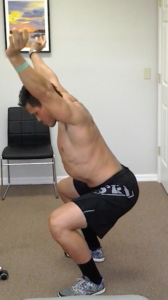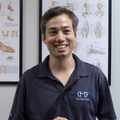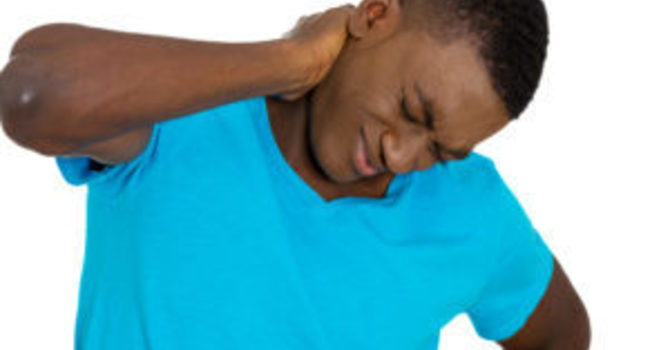
Findings:
Look at the bar path: The bar does not stay above the head and shoulders, and in fact goes forward of the knees. This puts the weight far away from his center of gravity. Not only will this limit how much he can lift, but it increases his risk of injury significantly, especially to his spine.
Look at the ribs: Excessive rib flare and compression of the back is seen. It is most pronounced between the lower back and mid back (aka thoracolumbar junction), likely site of pain or future pain if pattern continues.
Look at the neck and head: As he gets deeper into the squat and the bar comes forward, the mid back, neck, and head follow by flexing forward. This is a big energy loss happening at this moment, while simultaneously increasing his risk of spinal injury.
Overhead Squat Post Treatment Plan Assessment
In this case study, we see just how far our innovative manual medicine approach can take an athlete. With Pierre (above) we took a joint by joint approach in order to best improve his overhead squat.
Post Treatment Findings:
Bar path improvement: The bar path stays over his head and shoulders. It’s much easier to carry heavy weight when the bar remains over your center of gravity. Your spine is less likely to deviate from a centered alignment, and the risk of injury is dramatically decreased.
Ribs: There’s still some rib-flare occurring; however, it is much less, and therefore we know he’s not compressing the area between his lower back and mid back (thoracolumbar junction) nearly as much. This is a huge reduction in injury risk!
Neck and head: He’s no longer having to flex forward from his mid back, neck and head as he gets deeper in the squat. He’s able to maintain a neck packed position and strong alignment of the spine. We’ve done away with the energy leak that was occurring, and not only has his performance improved, but his risk of injury has decreased.
1.) Why Is The Overhead Squat So Important?
The overhead squat is the ultimate functional test, assessing the function of all of these joints at once:
- foot & ankle
- knees
- hips
- lower back and pelvis
- mid back and upper back
- neck
- shoulders
- elbows
- wrists and hands
With that being said, it is a test that is highly sensitive but not very specific. In other words it can quickly let you know that you have a mobility/stability issue somewhere in your body, but it doesn’t yet tell you exactly where. That’s why it’s important to then take a joint-by-joint assessment approach, really zeroing in on the key issue(s).
2.) Okay, So What Did We Do Next?
I took Pierre through a battery of movement assessments and prioritized his treatment plan to get the quickest results. His homework was to continue the mobility work as he had always done, before plateauing and seeking treatment with me. His treatment plan in the office consisted of identifying and treating the most relevant scar-tissue in his body.
For more information on how scar-tissue affects you, check out my Scar-Tissue Explained video.
3.) The Results!
You saw the video results above but there’s more to this story:
- Pierre has now hit a PR (personal record) in almost all of his lifts.
- Many of the aches and pains he had while squatting, cleared quickly (In the first few visits!).
- His positioning while working out has improved across the board.
- He has now qualified and competed in the men’s individual pro division Crossfit competitions.
- He considers the work we’ve done the best training investment he’s made off the gym floor.
“If you want to fast track PR’s and improve your mobility, I recommend you give Dr. Yinh a call. He has been my biggest asset off the gym floor and best investment in my training. I feel stronger and healthier with him in my corner.”
-Pierre Soero




